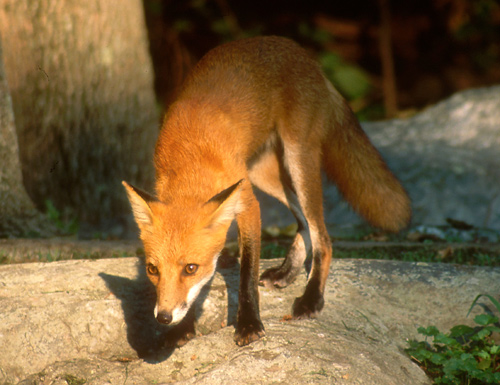Red Fox are widespread in Connecticut. These beautiful animals have red fur above and white underneath with black ears, lower legs and feet. The 14 to 17 inch, long, red, bushy tail has a distinctive white tip. Occasionally a Red Fox will exist in an all-black phase, or a silver phase where the black fur has white tips. Their eyes are orangey brown and the ears are large relative to their heads and triangular.
Gray Foxes have some patches of red fur that sometimes cause them to be mistaken for Red Foxes. However, most of their coat is a grizzled gray and they don't have a white-tipped tail.
Red Fox range through most of the US, except for some westernmost regions, and through Canada and Alaska. They are active year-round. They are usually most active at dawn, dusk and overnight, but it is not uncommon to see one about in daytime. Red Fox prefer habitat that is a combination of wooded areas, fields and brush. They are common in residential areas. In some cases, Red Foxes have adapted to become city dwellers.
Red Fox are omnivores and will dine on whatever is available. Smaller animals such as mice, voles, squirrels, rabbits, birds, frogs, crayfish and insects are eaten. They will eat vegetation, corn, berries and fruit in the warm months They will eat carrion and feed on human garbage. The scenario of a fox raiding the chicken coop is a classic one. Like Coyotes, Red Foxes will eat small pets such as cats and small dogs if the opportunity arises. Don't leave small pets outside unattended, especially at night, when Red Foxes live in your area. Fencing can be used to protect the garden plants they eat. Chicken coops and pens for other small livestock must be well sealed and fenced. Keep in mind that foxes can dig under fences or climb over ones that are small enough.
Red Foxes mate in January through March. During the breeding season Red Fox urine takes on a strong odor often mistaken for skunk musk. A mated fox pair will stick together closely during the breeding season and both parents care for the babies. The litter, produced in March or April, usually consists of 4 or 5 pups.
Red Foxes prepare several dens for their pups, usually by enlarging another creature's abandoned burrow. The space underneath a porch or deck might also be seen as appealing den space. If disturbed at one site, the foxes will move their young to one of the alternative dens. A den might be reused for several years for raising their young each season. The first fur grown by the pups is dark gray. They will keep this coat for about a month. By the time they are exploring outside the den in May they will be a sandy red. In late June they will grow the trademark bright red coat and are referred to as kits rather than pups.
Red Foxes are solitary except during the breeding season and while raising their young. Families disperse in the fall. Unless caring for a family, Red Foxes don't maintain a permanent home. A Red Fox will typically sleep out in the open curled up with its tail over its nose.
Red Foxes must live in between Coyote territories as Coyotes will not tolerate their presence. A typical Red Fox territory in Connecticut will be 2 to 4 square miles.
A regular, rasping, scream-like bark is one of the more commonly heard calls of the many sounds the red fox can make. People in residential areas are often puzzled by it. You can hear it in the center section of the audio link under the red fox photograph in this entry.
Neat Facts
Native Red Foxes lived in the northernmost regions of the US and in Canada before the mid-18th century. European Red Foxes were imported from England to the east coast of what is now the US for colonists who wanted to pursue fox-hunting. The modern Red Fox that has now expanded throughout the US is a hybrid of the native foxes and the European Red Fox.
Red Foxes can hear sounds in the low frequency range the best. They listen for the low frequency sounds made by rodents burrowing underground or under snow and dig towards such prey as quickly as they can.
